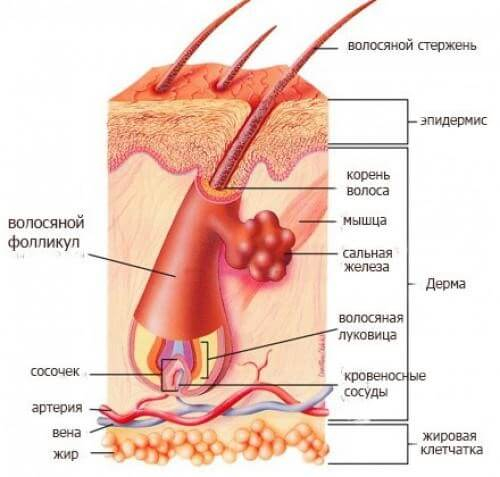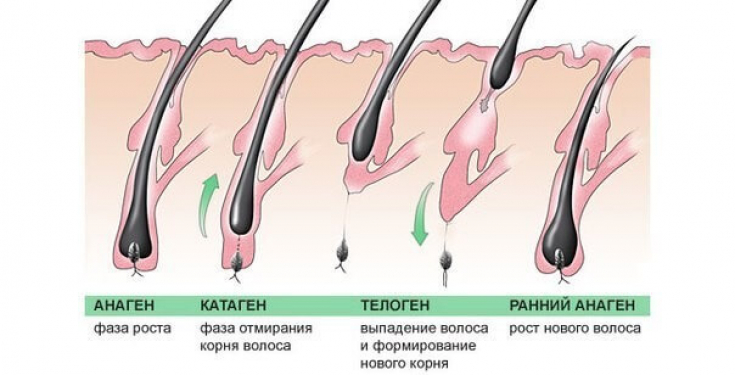Skin appendages are derived from accumulations of epidermal cells that differentiate at various stages of embryonic development.
Small epithelial buds appear in the third month of pregnancy and give rise to hair follicles, sebaceous and apocrine glands.
Eccrine sweat glands are formed from special epithelial outgrowths that appear in the second month of embryonic development and complete formation before five months.
Nails begin to form in the third month of fetal development.
Find out in the article on estet-portal.com about the features of the manifestation of the main symptoms and syndromes of congenital forms of pathology of hair follicles, as well as hair structure.
- Structure and physiology of the hair follicle
- Diseases that are associated with hair follicles
- Genetic diseases associated with impaired function of hair follicles and hair structurec
Structure and physiology of the hair follicle
Hair follicles − it is an integral part of the hair complex, which includes the sebaceous gland, the muscle that raises the hair, and in the inguinal regions also the apocrine sweat glands.
Follow us on Instagram!
Hair follicles are located on the entire surface of the skin, except for the palms, soles, lips and glans penis.
They are unable to recover from damage.
At birth, all hair is in the anagen (growth) phase.
Then, hair growth loses synchrony and the predominance of the growth phase and the resting phase (telogen phase) is random.
Hair damage caused by:
- metabolic or biochemical defects of a general nature;
- structural abnormalities of the hair shaft;
- inflammatory dermatoses;
- infections;
- certain drugs;
- endocrinopathymi.
Diseases associated with hair follicles
Excessive hair − hirsutism (hypertrichosis), insufficient hair growth − hypotrichosis, and partial or complete loss of hair on the head − alopecia − rare events in young children.

In addition to these disorders, defects in the hair structure can be observed in the form of:
1. Trichoclasia nodosum − frequent defect of the hair shaft; hair dry, brittle, lacking shine.
Observed as a manifestation of hereditary diseases (Menkes syndrome, Netherton syndrome, arginine-succinic acidemia), but can also be an isolated genetic defect;
2. Changed hair − frequent defect of the hair shaft, which manifests itself at the age of 3 months - 2 years.
At the same time, the hair is twisted at different angles to its axis, it is coarse, brittle, and has an uneven sheen.
This symptom is a manifestation of a number of syndromes (Base, Bernstad, Krendol, Rapp-Hodgkin), trichothiodystrophy;
3. Ring hair − alternation of dark and light stripes along the length of the hair shaft.
No breakage. May be a variant of the norm;
4. Trichothiodystrophy – hair on the head, eyebrows, eyelids is thin, short, brittle, uneven.
Occurs as an isolated pathology or as a component of a number of syndromes characterized by oligophrenia, short stature, ichthyosis, cataracts, neurological disorders, bone anomalies, immunodeficiencyom.
Dry – no: effective moisturizing of the hair
Genetic diseases associated with impaired function of hair follicles and hair structure
1. Menkes syndrome (curly hair disease, trichopoliodystrophy) − a genetic disease associated with a violation of the distribution of copper in the body.
Children born to healthy mothers after a normal pregnancy experience:
- hypothermia;
- muscular hypotension;
- delayed physical development;
- progressive psychomotor retardation;
- convulsions.
Birth hair is normal or liquid.
Later, the hair becomes short, thin, brittle, weakly colored, distorted or with signs of moniletrix.

This disease also has skin changes:
- hypopigmented skin;
- thin cheeks;
- bridges depressed.
Introduction of copper salts (copper histidinate at a dose of 0.2-0.45 mg per day) ensures the restoration of the normal content of copper ions and causes a positive effect.
If you follow a special diet, you can avoid severe manifestations of the disease and significantly improve the quality of life of the child.
2. Thick Curly Hair Syndrome − already manifested at the birth of a child by the growth of curly hair.
As the child grows, this sign increases, but after puberty it weakens.
3. Moniletrix − the hair is dry, brittle with minor damage, while the hair changes occur not only on the head, but also on other parts of the body.
At the birth of a child, the hair may be normal, but within a few months of life, it is replaced by a modified one.
Hair loss and the prospects of nanotechnology
Possible spontaneous improvement after puberty, during pregnancy and when using oral contraceptives, reflecting a possible endocrine pathology as the cause of the disease.







Add a comment